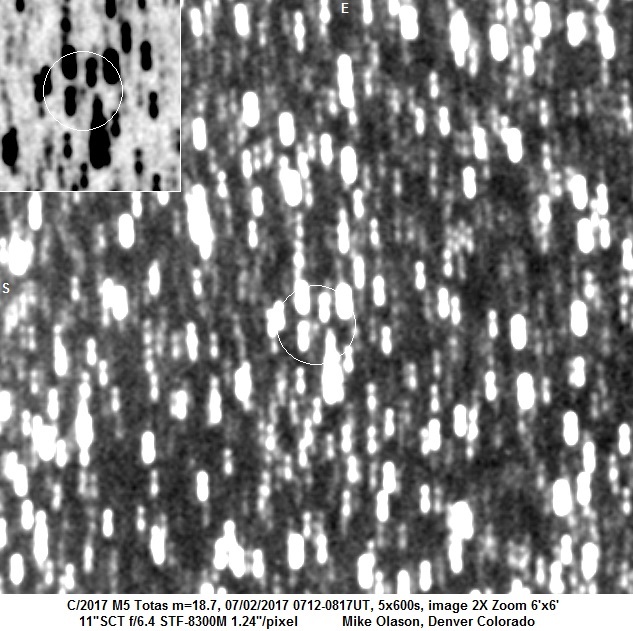Observation by Mike Olason: C/2017 M5 Totas
Uploaded by
Observer
Mike Olason
Observed
2017 Jul 02 - 06:12
Uploaded
2017 Jul 10 - 07:24
Objects
Equipment
- 11" SCT f/6.4
- STF-8300M
Exposure
5x600s
Location
Denver Colorado
Target name
C/2017 M5 Totas
Title
C/2017 M5 Totas

About this image
New comet C/2017 M5 Totas was discovered June 23. It will reach magnitude 18 in 2018 before fading below magnitude 20 in 2021. Because the faint comet is in a very crowded star field this is a 2X Zoom image that has a FOV of only 6'x6' to show the comet.
Files associated with this observation
Like this image
Comments
Amazing what you are achieving here Mike. I have just bought a monochrome imaging camera (for sensitivity) and am waiting for proper astronomical darkness in September before I try my hand at imaging faint solar system objects. I'd love to prepare animations showing movement of objects against the star background, for showing people in the village. I don't suppose I'll get down (or up,I suppose!) to the magnitudes you achieve though. All the best - David
Thank you for your kind words. I have enjoyed looking at your images of Jupiter and Saturn. I look forward to viewing your animations of comets, asteroids, etc. I have seen a few animations of comets and that looks to be the future in comet/asteroid imaging as the chips get more sensitive. It will be interesting to see what software you eventually determine does the best job with the animation sequence. I would think that with an 8" SCT that you should be able to create animations of comets that are as dim as magnitude 15 eventually and as you figure out all the problems associated with animation you probably will go much dimmer. I suppose that with the 11" SCT that I use animations could probably be created down to about magnitude 19 under good seeing conditions. Dimmer than magnitude 19 usually requires averaging of images (even long exposures) to bring the comet out of the background noise. If you don't mind my asking, what will your imaging setup look like with the mono CCD Camera? If I were you, I would start imaging now in the twilight conditions. I am always trying to image comets in morning or evening twilight, usually with pretty good results, why, because that is where the interesting ones always seem to be! If the Sun is 10-15 degrees below the horizon I can usually get a decent image to show the comet depending on how bright the comet actually is since integration time is usually limited before saturation of the chip occurs. So in your situation where you have a new camera, get out there and try it on brighter comets now, you might be surprised at what you can see especially if you average a number of shorter images to reduce the noise while keeping the chip from saturating. I would also think that if you have determined an equipment setup then you should be able to create some good darks with all that twilight that you have. I hope that you share with us your experiences (good and bad) of getting to the point where you successfully create good animations of a lot of comets.
I realize that you have a lot of very knowledgeable astronomers that you can talk directly to over there, but if you have any questions don't be afraid to ask.
Good luck,
Mike
So, the set up will be a cooled ASI178MM (2x2 binning I think because the pixels are very small) with my C8 and f/6.3 focal reducer in place. I don't have a permanent observing spot, so I tend to use my alt-az mount for ease and speed, but I think I will need to deploy the equatorial one to achieve the best images (longer exposures without field rotation). I thought perhaps I would prepare the still images first in Photoshop, then stitch together the animation in PIPP - although of course that software was designed for the planets. I will definitely keep you informed and continue asking for advice! David
© British Astronomical Association 2026
Registered charity no. 210769
Registered company no. 117572
For more information including contact details,
click here.
Our Terms of Use are here.
Our Privacy Policy is here.

The BAA image gallery was designed and
built by Dominic Ford.
Image gallery software
©
Dominic Ford
2020–2024
